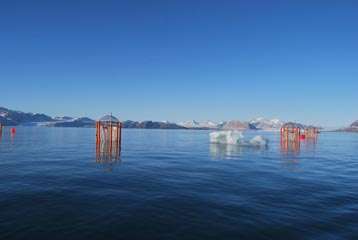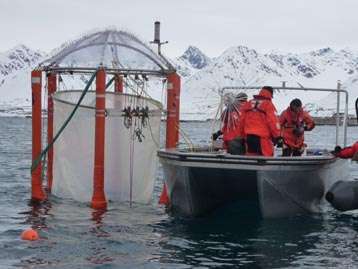EPOCA experiment, Ny-Ålesund, Spitzbergen 2010. Credit: Ray Zhang, University of Xiamen, China
Could the future of the ocean depend on its smallest organisms? An experiment conducted as part of the European project EPOCA, coordinated by Jean-Pierre Gattuso of the Laboratoire d'Océanographie de Villefranche (CNRS/UPMC), has shown that pico- and nanoplankton benefit from increases in carbon dioxide (CO2) concentration in the seawater, causing a disruption in the food chain. Two climate regulation processes are also affected: carbon export to the deep ocean and production of dimethyl sulfide, a gas that counteracts the greehouse effect. The study was conducted in the Arctic by a team of researchers, mainly from GEOMAR, CNRS and UPMC, supported by the Institut Polaire Français. These results have been published in a special issue of Biogeosciences.
Since 1800, about a third of the CO2 emissions from human activity have been absorbed by the world's oceans (equivalent to a metric ton of CO2 per person). This absorption causes ocean acidification, which was the subject of a four-year study by the project EPOCA (European Project on Ocean Acidification). Launched in 2008 and coordinated by CNRS researcher Jean-Pierre Gattuso at LOV, EPOCA combines the skills of more than 160 researchers from 32 European institutions. In 2010, one of the most important experiments was conducted over five weeks in the Arctic Ocean, whose low temperature means that it absorbs more CO2 than other oceans. Acidification is therefore more rapid in the Arctic than in temperate or tropical areas. It was also important to perform this experiment in the field so as to take account of the ecological relationships between organisms at the community level (competition, predation...) and compare these results with those of laboratory studies..
At the end of May 2010, the international team conducting this experiment, made up of 35 researchers and led by Ulf Riebesell of the German institute GEOMAR, set up nine mesocosms-resembling giant floating test tubes-in Kings Bay off Ny-Ålesund, to the west of Spitsbergen. These mesocosms are made of huge plastic bags of 50 m3 held in shape by 8 m-tall frames, which can hold the entire cross-section of plankton present in the fjord. In seven of these bags, the CO2 concentration was gradually increased to reach the level expected in 20, 40, 60, 80 and 100 years' time. Another two of the bags served as "control bags", representing unmodified natural conditions. Fifty biological and chemical parameters were then measured every day and samples collected regularly for laboratory analyses.
EPOCA experiment, Ny-Ålesund, Spitzberg 2010. Researchers preparing to inject CO2-rich water into the mesocosms using a "spider". Credit: Jean-Pierre Gattuso (LOV, CNRS/UPMC)
The main result was that the smallest plankton, the pico- and nanoplankton, grow more rapidly and produce more organic carbon when CO2 levels are high. But, as these tiny plankton proliferate, they consume mineral salts, like nitrates, which would otherwise be available for larger species. The growth of these tiny plankton, which are at the bottom of the food chain, therefore deprives the diatoms, larger phytoplankton belonging to the microplankton. This experiment was too short to determine whether the phenomonon would have an impact on the nutrition of zooplankton, which feed on phytoplankton.
Moreover, ecosystems dominated by pico- and nanoplankton export less carbon to the deep ocean, which could reduce CO2 absorption by the oceans. Another process contributing to climate regulation that could also be affected is the production of dimethyl sulfide (DMS). This gas is released by phytoplankton and favors cloud formation over the ocean. At high CO2 concentrations, the researchers observed reduced DMS production, which would cause an increase in the amount of solar radiation reaching the Earth's surface and thus intensify the greenhouse effect. In addition to the marine food chain, ocean acidification would thus also affect processes that play an important role in climate regulation.
More information: Riebesell, U. et al. Arctic ocean acidification: pelagic ecosystem and biogeochemical responses during a mesocosm study, Biogeosciences Special Issue. Volume 10, 5619-5626, 2013. DOI: 10.5194/bg-10-5619-2013
Journal information: Biogeosciences
Provided by CNRS























